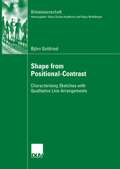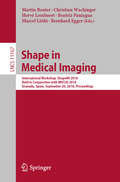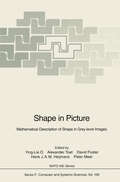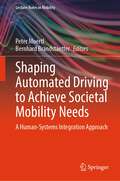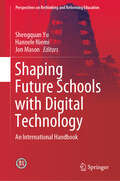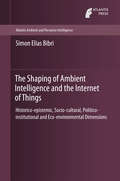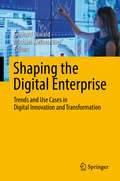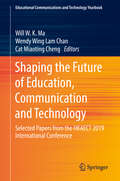- Table View
- List View
Shape Detection in Computer Vision Using the Hough Transform
by V.F. LeaversShape detection techniques are an important aspect of computer vision and are used to transform raw image data into the symbolic representations needed for object recognition and location. However, the availability and application of research data relating to shape detection has traditionally been limited by a lack of computational and mathematical skill on the part of the intended end-user. As a result progress in areas such as the automation of visual inspection techniques, where shape detection couls play a pivotal role, has been relatively slow. In this volume, Violet Leavers, an established author and researcher in the field, examines the Hough Transform, a technique which is particularly relevant to industrial applications. By making computational recipes and advice available to the non-specialist, the book aims to popularize the technique, and to provide a bridge between low level computer vision tasks and specialist applications. In addition, Shape Detection in Computer Vision Using the Hough Transform assesses practical and theoretical issues which were previously only available in scientific literature in a way which is easily accessible to the non-specialist user. Shape Detection in Computer Vision Using the Hough Transform fills an obvious gap in the existing market. It is an important textbook which will provide postgraduate students with a thorough grounding in the field, and will also be of interest to junior research staff and program designers.
Shape from Positional-Contrast: Characterising Sketches with Qualitative Line Arrangements (Bildwissenschaft)
by Björn GottfriedBjörn Gottfried introduces the notion of positional-contrast. It defines how patterns can be robustly dealt with. That is, the new representation distinguishes patterns by how they relate with regard to spatial relations. This notion can be applied for several purposes, including pattern recognition, motion analysis, and texture analysis.
Shape in Medical Imaging: International Workshop, Shapemi 2018, Held In Conjunction With Miccai 2018, Granada, Spain, September 20, 2018, Proceedings (Lecture Notes in Computer Science #11167)
by Bernhard Egger Marcel Lüthi Beatriz Paniagua Hervé Lombaert Christian Wachinger Martin ReuterThis book constitutes the proceedings of the Workshop on Shape in Medical Imaging, ShapeMI 2018, held in conjunction with the 21st International Conference on Medical Image Computing, MICCAI 2018, in Granada, Spain, in September 2018. The 26 full papers and 2 short papers presented were carefully reviewed and selected for inclusion in this volume. The papers discuss novel approaches and applications in shape and geometry processing and their use in research and clinical studies and explore novel, cutting-edge theoretical methods and their usefulness for medical applications, e.g., from the fields of geometric learning or spectral shape analysis.
Shape in Medical Imaging: International Workshop, ShapeMI 2020, Held in Conjunction with MICCAI 2020, Lima, Peru, October 4, 2020, Proceedings (Lecture Notes in Computer Science #12474)
by Martin Reuter Christian Wachinger Hervé Lombaert Beatriz Paniagua Orcun Goksel Islem RekikThis book constitutes the proceedings of the International Workshop on Shape in Medical Imaging, ShapeMI 2020, which was held in conjunction with the 23rd International Conference on Medical Image Computing and Computer Assistend Intervention, MICCAI 2020, in October 2020. The conference was planned to take place in Lima, Peru, but changed to a virtual format due to the COVID-19 pandemic. The 12 full papers included in this volume were carefully reviewed and selected from 18 submissions. They were organized in topical sections named: methods; learning; and applications.
Shape in Medical Imaging: International Workshop, ShapeMI 2023, Held in Conjunction with MICCAI 2023, Vancouver, BC, Canada, October 8, 2023, Proceedings (Lecture Notes in Computer Science #14350)
by Christian Wachinger Beatriz Paniagua Shireen Elhabian Jianning Li Jan EggerThis volume comprises the proceedings of the International Workshop, ShapeMI 2023, which took place alongside MICCAI 2023 on October 8, 2023, in Vancouver, British Columbia, Canada.The 23 selected full papers deal with all aspects of leading methods and applications for advanced shape analysis and geometric learning in medical imaging.
Shape in Picture: Mathematical Description of Shape in Grey-level Images (NATO ASI Subseries F: #126)
by Ying-Lie O Alexander Toet David Foster Henk J. A M. Heijmans Peter MeerThe fields of image analysis, computer vision, and artificial intelligence all make use of descriptions of shape in grey-level images. Most existing algorithms for the automatic recognition and classification of particular shapes have been devel oped for specific purposes, with the result that these methods are often restricted in their application. The use of advanced and theoretically well-founded math ematical methods should lead to the construction of robust shape descriptors having more general application. Shape description can be regarded as a meeting point of vision research, mathematics, computing science, and the application fields of image analy sis, computer vision, and artificial intelligence. The NATO Advanced Research Workshop "Shape in Picture" was organised with a twofold objective: first, it should provide all participants with an overview of relevant developments in these different disciplines; second, it should stimulate researchers to exchange original results and ideas across the boundaries of these disciplines. This book comprises a widely drawn selection of papers presented at the workshop, and many contributions have been revised to reflect further progress in the field. The focus of this collection is on mathematical approaches to the construction of shape descriptions from grey-level images. The book is divided into five parts, each devoted to a different discipline. Each part contains papers that have tutorial sections; these are intended to assist the reader in becoming acquainted with the variety of approaches to the problem.
Shape Interrogation for Computer Aided Design and Manufacturing
by Nicholas M. Patrikalakis Takashi MaekawaShape interrogation is the process of extraction of information from a geometric model. It is a fundamental component of Computer Aided Design and Manufacturing (CAD/CAM) systems. This book provides a bridge between the areas geometric modeling and solid modeling. Apart from the differential geometry topics covered, the entire book is based on the unifying concept of recasting all shape interrogation problems to the solution of a nonlinear system. It provides the mathematical fundamentals as well as algorithms for various shape interrogation methods including nonlinear polynomial solvers, intersection problems, differential geometry of intersection curves, distance functions, curve and surface interrogation, umbilics and lines of curvature, and geodesics.
The Shape of Future Technology: The Anthropocentric Alternative (Human-centred Systems)
by Peter BrödnerMike Cooley One of the most remarkable features of modern industrial society, is the gap between that which technology could provide for society (its potential) and that which it actually does provide for society (its reality). We have for example, complex control systems which can guide a missile to another continent with extraordinary accuracy, yet the blind and the disabled have to stagger around our cities in very much the same way as they did in mediaeval times. There are advanced communication systems enabling messages to be sent around the world in a fraction of a second, but it now takes longer to send an ordinary letter from Washington to New York than it did in the days of the stage coach. Such a growing chasm between potential and reality, is giving rise to a thorough questioning of many of the orthodoxies in these areas and the priorities on which they are based. Similar contradictions, even if at this stage less obvious and dramatic, abound in the field of manufacturing technology. There, we find technologies which have the potential of liberating human beings from soul destroying, routine, backbreaking tasks and leave them free to engage in more creative work, but which in reality, often end up reducing the human being to a mere machine appendage, acted upon by the technology and becoming a passive, pathetic element in the productive system rather than a creative, dynamic human being.
Shape Optimization Problems (Springer Optimization and Its Applications #164)
by Hideyuki AzegamiThis book provides theories on non-parametric shape optimization problems, systematically keeping in mind readers with an engineering background. Non-parametric shape optimization problems are defined as problems of finding the shapes of domains in which boundary value problems of partial differential equations are defined. In these problems, optimum shapes are obtained from an arbitrary form without any geometrical parameters previously assigned. In particular, problems in which the optimum shape is sought by making a hole in domain are called topology optimization problems. Moreover, a problem in which the optimum shape is obtained based on domain variation is referred to as a shape optimization problem of domain variation type, or a shape optimization problem in a limited sense. Software has been developed to solve these problems, and it is being used to seek practical optimum shapes. However, there are no books explaining such theories beginning with their foundations.The structure of the book is shown in the Preface. The theorems are built up using mathematical results. Therefore, a mathematical style is introduced, consisting of definitions and theorems to summarize the key points. This method of expression is advanced as provable facts are clearly shown. If something to be investigated is contained in the framework of mathematics, setting up a theory using theorems prepared by great mathematicians is thought to be an extremely effective approach. However, mathematics attempts to heighten the level of abstraction in order to understand many things in a unified fashion. This characteristic may baffle readers with an engineering background. Hence in this book, an attempt has been made to provide explanations in engineering terms, with examples from mechanics, after accurately denoting the provable facts using definitions and theorems.
Shape Perception in Human and Computer Vision: An Interdisciplinary Perspective (Advances in Computer Vision and Pattern Recognition)
by Sven J. Dickinson and Zygmunt PizloThis comprehensive and authoritative text/reference presents a unique, multidisciplinary perspective on Shape Perception in Human and Computer Vision. Rather than focusing purely on the state of the art, the book provides viewpoints from world-class researchers reflecting broadly on the issues that have shaped the field. Drawing upon many years of experience, each contributor discusses the trends followed and the progress made, in addition to identifying the major challenges that still lie ahead. Topics and features: examines each topic from a range of viewpoints, rather than promoting a specific paradigm; discusses topics on contours, shape hierarchies, shape grammars, shape priors, and 3D shape inference; reviews issues relating to surfaces, invariants, parts, multiple views, learning, simplicity, shape constancy and shape illusions; addresses concepts from the historically separate disciplines of computer vision and human vision using the same “language” and methods.
Shape Reconstruction from Apparent Contours: Theory and Algorithms (Computational Imaging and Vision #44)
by Giovanni Bellettini Valentina Beorchia Maurizio Paolini Franco PasquarelliMotivated by a variational model concerning the depth of the objects in a picture and the problem of hidden and illusory contours, this book investigates one of the central problems of computer vision: the topological and algorithmic reconstruction of a smooth three dimensional scene starting from the visible part of an apparent contour.The authors focus their attention on the manipulation of apparent contours using a finite set of elementary moves, which correspond to diffeomorphic deformations of three dimensional scenes.A large part of the book is devoted to the algorithmic part, with implementations, experiments, and computed examples. The book is intended also as a user's guide to the software code appcontour, written for the manipulation of apparent contours and their invariants. This book is addressed to theoretical and applied scientists working in the field of mathematical models of image segmentation.
Shape Understanding System: Machine Understanding and Human Understanding (Studies in Computational Intelligence #588)
by Zbigniew Les Magdalena LesThis is the third book presenting selected results of research on the further development of the shape understanding system (SUS) carried out by authors in the newly founded Queen Jadwiga Research Institute of Understanding. In this book the new term Machine Understanding is introduced referring to a new area of research aiming to investigate the possibility of building machines with the ability to understand. It is presented that SUS needs to some extent mimic human understanding and for this reason machines are evaluated according to the rules applied for the evaluation of human understanding. The book shows how to formulate problems and how it can be tested if the machine is able to solve these problems.
Shape Understanding System: The First Steps toward the Visual Thinking Machines (Studies in Computational Intelligence #86)
by Zbigniew Les Magdalena LesThis book presents the results of research into one of the most complex and difficult areas - research into thinking and understanding. The research was carried out at the newly founded Queen Jadwiga Research Institute of Understanding and is focused on the problem of visual understanding and visual thinking. The authors believe this is the first book to attempt to investigate the complexity of visual thinking problems in the context of building the thinking machine.
Shape Understanding System – Knowledge Implementation and Learning (Studies in Computational Intelligence #425)
by Zbigniew Les Magdalena LesThis book presents the selected results of research on the further development of the shape understanding system (SUS) described in our previous book titled “Shape Understanding System: the First Steps Toward the Visual Thinking Machines”. This is the second book that presents the results of research in the area of thinking and understanding carried out by authors in the newly founded the Queen Jadwiga Research Institute of Understanding. In this book, the new term knowledge implementation is introduced to denote the new method of the meaningful learning in the context of machine understanding. SUS ability to understand is related to the different categories of objects such as the category of visual objects, the category of sensory objects and the category of text objects. In this book, new terms and concepts are introduced in order to describe and explain some issues connected with SUS development. These terms are explained by referring to the content of our books and other our works rather than to existing literature in related areas of research. This book raises many questions that are discussed in the area of cognitive science or philosophy of mind.
Shaping Automated Driving to Achieve Societal Mobility Needs: A Human-Systems Integration Approach (Lecture Notes in Mobility)
by Peter Moertl Bernhard BrandstaetterThis edited book describes novel human-systems integration approaches to improve acceptance, safety, and comfort of automated vehicles. Each chapter analyses different aspects in the development of automated driving systems such as: assessing needs and opportunities of specific user populations i.e. elderly drivers and truck drivers; creating fluid human-systems interactions in the vehicle to answer specific driver needs; developing an automated driving tutoring application; and identifying benefits of including road infrastructure sensors to support automated driving predictability. A detailed description of the assessment of the above-described solutions in real-world situations is also included. Written by both researchers and professionals, this book offers timely and practice-oriented information concerning the development of automated driving systems that better adapt to the users’ needs.
Shaping Future Schools with Digital Technology: An International Handbook (Perspectives on Rethinking and Reforming Education)
by Shengquan Yu Hannele Niemi Jon MasonThis book presents an overview of education technology and its use in schools, with a primary emphasis on best practices of technology enhanced learning; how new technologies such as mobile, augmented and wearable technologies affect instructional design strategies; and the content curriculum development process. Providing insights into the future of education and the upcoming pedagogies that will be applied in schools, it helps educators and other stakeholders make innovations for the new generations of learners in the 21st century.The use of emerging technologies such as mobile and ubiquitous technologies, context-aware technology, augment-reality, and virtual reality is contributing to making education adaptive and smarter. With the ever-changing technologies, how to equip teachers with these digital skills and transform their teaching style is also important to ensure that school education is more individualised and customised for students.Offering a global perspective with integrated practical cases, this timely book is of interest to educators, teachers, and education policymakers. And although most of the authors are from the academia, it provides non-experts with a novel view of what future schools will be like with the help of technology.
The Shaping of Ambient Intelligence and the Internet of Things: Historico-epistemic, Socio-cultural, Politico-institutional and Eco-environmental Dimensions (Atlantis Ambient and Pervasive Intelligence #10)
by Simon Elias BibriRecent advances in ICT have given rise to new socially disruptive technologies: AmI and the IoT, marking a major technological change which may lead to a drastic transformation of the technological ecosystem in all its complexity, as well as to a major alteration in technology use and thus daily living. Yet no work has systematically explored AmI and the IoT as advances in science and technology (S&T) and sociotechnical visions in light of their nature, underpinning, and practices along with their implications for individual and social wellbeing and for environmental health. AmI and the IoT raise new sets of questions: In what way can we conceptualize such technologies? How can we evaluate their benefits and risks? How should science–based technology and society’s politics relate? Are science-based technology and society converging in new ways? It is with such questions that this book is concerned. Positioned within the research field of Science and Technology Studies (STS), which encourages analyses whose approaches are drawn from a variety of disciplinary perspectives, this book amalgamates an investigation of AmI and the IoT technologies based on a unique approach to cross–disciplinary integration; their ethical, social, cultural, political, and environmental effects; and a philosophical analysis and evaluation of the implications of such effects. An interdisciplinary approach is indeed necessary to understand the complex issue of scientific and technological innovations that S&T are not the only driving forces of the modern, high–tech society, as well as to respond holistically, knowledgeably, reflectively, and critically to the most pressing issues and significant challenges of the modern world. This book is the first systematic study on how AmI and the IoT applications of scientific discovery link up with other developments in the spheres of the European society, including culture, politics, policy, ethics and ecological philosophy. It situates AmI and the IoT developments and innovations as modernist science–based technology enterprises in a volatile and tense relationship with an inherently contingent, heterogeneous, fractured, conflictual, plural, and reflexive postmodern social world.The issue’s topicality results in a book of interest to a wide readership in science, industry, politics, and policymaking, as well as of recommendation to anyone interested in learning the sociology, philosophy, and history of AmI and the IoT technologies, or to those who would like to better understand some of the ethical, environmental, social, cultural, and political dilemmas to what has been labeled the technologies of the 21st century.
Shaping the Digital Enterprise: Trends and Use Cases in Digital Innovation and Transformation
by Gerhard Oswald Michael KleinemeierThis book sheds light on cross-industry and industry-specific trends in today’s digital economy. Prepared by a group of international researchers, experts and practitioners under the auspices of SAP’s Digital Thought Leadership & Enablement team within SAP’s Business Transformation Services (BTS) unit, the book furthermore presents relevant use cases in digital transformation and innovation. The book argues that breakthrough technologies have matured and hit scale together, enabling five defining trends: hyper-connectivity, supercomputing, cloud computing, a smarter world, and cyber security. It presents in detail how companies are now reimagining their products and services, business models and processes, showcasing how every business today is a digital business. Digitalization, defined as the process of moving to a digital business, is no longer a choice but an imperative for all businesses across all industries and regions. Taking a step toward becoming a digital enterprise is demanding and challenging. The dimensions of customer centricity, leadership and strategy, business models, including offerings (products and services), processes, structure and governance, people and skills, culture, and technology foundation can serve as orientation for digitalization. The articles in this book touch on all dimensions of this digital innovation and transformation framework and offer possible answers to some of the pressing questions that arise when practitioners seek to digitalize their business.
Shaping the Digital Transformation of the Education Ecosystem in Europe: 31st EDEN Annual Conference 2022, Tallinn, Estonia, June 20–22, 2022, Proceedings (Communications in Computer and Information Science #1639)
by Mart Laanpere Terje VäljatagaThis book constitutes refereed proceedings of the 31st Annual Conference on European Distance and E-Learning Network, EDEN 2022, held in Tallinn, Estonia, from June 20–22, 2022. The 11 full papers and 2 short papers presented in this volume were carefully reviewed and selected from a total of 78 submissions. The papers in the volume are organised according to the following topical headings: higher education; teachers’ professional development; digital competencies; inclusive education
Shaping the Future of Education, Communication and Technology: Selected Papers from the HKAECT 2019 International Conference (Educational Communications and Technology Yearbook)
by Will W. K. Ma Wendy Wing Lam Chan Cat Miaoting ChengThis book gathers selected papers from the Hong Kong Association for Educational Communications and Technology 2019 International Conference on the theme of “Shaping the Future of Education, Communication and Technology.” It contributes to a scholarly discussion that looks beyond what future media and technology can offer for education, and reflects on best practices and lessons learned from applying new media and technology in a wide range of fields. Scholars from educational technology, communication, and higher education share their research work in various formats such as empirical research, best-practice case studies, literature reviews, etc. The topics of the papers are divided into four main areas, including curriculum, pedagogy and instructional design; teaching and learning experiences with technology; online learning and open education resources; and communication and media. The book’s unique quality is its combination of perspectives and research work on communication, education and technology. Thus, it will encourage an interdisciplinary discourse and exchange concerning communication, new media, and educational practices.
Shaping the Future of ICT: Trends in Information Technology, Communications Engineering, and Management
by Ibrahiem M. M. El Emary Anna BrzozowskaThe International Conference on Communications, Management, and Information Technology (ICCMIT’16) provides a discussion forum for scientists, engineers, educators and students about the latest discoveries and realizations in the foundations, theory, models and applications of systems inspired on nature, using computational intelligence methodologies, as well as in emerging areas related to the three tracks of the conference: Communication Engineering, Knowledge, and Information Technology. The best 25 papers to be included in the book will be carefully reviewed and selected from numerous submissions, then revised and expanded to provide deeper insight into trends shaping future ICT.
Shaping the Future of ICT: Trends in Information Technology, Communications Engineering, and Management
by Ibrahiem M. M. El Emary and Anna BrzozowskaThe International Conference on Communications, Management, and Information Technology (ICCMIT’16) provides a discussion forum for scientists, engineers, educators and students about the latest discoveries and realizations in the foundations, theory, models and applications of systems inspired on nature, using computational intelligence methodologies, as well as in emerging areas related to the three tracks of the conference: Communication Engineering, Knowledge, and Information Technology. The best 25 papers to be included in the book will be carefully reviewed and selected from numerous submissions, then revised and expanded to provide deeper insight into trends shaping future ICT.
Shaping the Future of ICT Research: IFIP WG 8.2 Working Conference, Tampa, FL, USA, December 13-14, 2012, Proceedings (IFIP Advances in Information and Communication Technology #389)
by Anol Bhattacherjee Brian FitzgeraldThis book constitutes the refereed proceedings of the IFIP WG 8.2 Working Conference "Shaping the Future of ICT Research", held in Tampa, FL, USA, in December 2012. The 15 revised full papers presented were carefully reviewed and selected from numerous submissions. The papers are organized in the following topical sections: new methods in design science research; recent developments in inductive research methods; emerging themes in interpretive case study research; new ideas in positivist research; and innovative trends in information systems research.
Shaping the Future of IoT with Edge Intelligence: How Edge Computing Enables the Next Generation of IoT Applications (River Publishers Series in Communications and Networking)
by Rute Sofia John SoldatosThis book presents the technologies that empower edge intelligence, along with their use in novel IoT solutions. Specifically, it presents how 5G/6G, Edge AI, and Blockchain solutions enable novel IoT-based decentralized intelligence use cases at the edge of the cloud/edge/IoT continuum. Emphasis is placed on presenting how these technologies support a wide array of functional and non-functional requirements spanning latency, performance, cybersecurity, data protection, real-time performance, energy efficiency, and more. The various chapters of the book are contributed by several EU-funded projects, which have recently developed novel IoT platforms that enable the development and deployment of edge intelligence applications based on the cloud/edge paradigm. Each one of the projects employs its own approach and uses a different mix of networking, middleware, and IoT technologies. Therefore, each of the chapters of the book contributes a unique perspective on the capabilities of enabling technologies and their integration in practical real-life applications in different sectors. The book is structured in five distinct parts. Each one of the first four parts focuses on a specific set of enabling technologies for edge intelligence and smart IoT applications in the cloud/edge/IoT continuum. Furthermore, the fifth part provides information about complementary aspects of next-generation IoT technology, including information about business models and IoT skills. Specifically: The first part focuses on 5G/6G networking technologies and their roles in implementing edge intelligence applications. The second part presents IoT applications that employ machine learning and other forms of Artificial Intelligence at the edge of the network. The third part illustrates decentralized IoT applications based on distributed ledger technologies. The fourth part is devoted to the presentation of novel IoT applications and use cases spanning the cloud/edge/IoT continuum. The fifth part discusses complementary aspects of IoT technologies, including business models and digital skills.
Shaping the Future of IoT with Edge Intelligence: How Edge Computing Enables the Next Generation of IoT Applications (River Publishers Series in Communications and Networking)
This book presents the technologies that empower edge intelligence, along with their use in novel IoT solutions. Specifically, it presents how 5G/6G, Edge AI, and Blockchain solutions enable novel IoT-based decentralized intelligence use cases at the edge of the cloud/edge/IoT continuum. Emphasis is placed on presenting how these technologies support a wide array of functional and non-functional requirements spanning latency, performance, cybersecurity, data protection, real-time performance, energy efficiency, and more. The various chapters of the book are contributed by several EU-funded projects, which have recently developed novel IoT platforms that enable the development and deployment of edge intelligence applications based on the cloud/edge paradigm. Each one of the projects employs its own approach and uses a different mix of networking, middleware, and IoT technologies. Therefore, each of the chapters of the book contributes a unique perspective on the capabilities of enabling technologies and their integration in practical real-life applications in different sectors. The book is structured in five distinct parts. Each one of the first four parts focuses on a specific set of enabling technologies for edge intelligence and smart IoT applications in the cloud/edge/IoT continuum. Furthermore, the fifth part provides information about complementary aspects of next-generation IoT technology, including information about business models and IoT skills. Specifically: The first part focuses on 5G/6G networking technologies and their roles in implementing edge intelligence applications. The second part presents IoT applications that employ machine learning and other forms of Artificial Intelligence at the edge of the network. The third part illustrates decentralized IoT applications based on distributed ledger technologies. The fourth part is devoted to the presentation of novel IoT applications and use cases spanning the cloud/edge/IoT continuum. The fifth part discusses complementary aspects of IoT technologies, including business models and digital skills.

